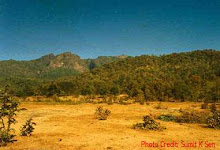Quaint and sublime, the forests of Bandhavgarh Tiger Reserve are a veritable paradise on Earth. Hidden deep inside in remote access of Central India - the park is an amazing biodiversity hub.
Known more for its tigers, one can experience India's enchanting wilderness at best here. Every year thousands of overseas and local visitors arrive here for a tiger safari.
The scattered ruins enhance the esoteric charm of Bandhavgarh suggesting history that dates back 2000 years. A game round takes you way back into a turbulent past of Maharajahs amidst teeming wildlife.
The diverse flora changes landscapes with startling fervor as you move into the bush country, dense forests, and rolling grasslands. The marshy landscape accord immense beauty and it is here that you can see the tiger in the wild.
Known for Sal (Shorea robusta) trees and the moist deciduous types abound along with mixed canopy. Though the reserve encompasses a large area of about eleven hundred km the tourism zone is restricted to four hundred plus km. This is a big enough window to peek into the magnificent wilderness.
Deer, bison, leopard, sloth bear, and wild dogs share the kingdom of magnificent tigers. Birds abound and are a treat to watch as they emerge from the dense canopy in resplendent attire. Bandhavgarh is a bird-watching hot spot in India sadly neglected and suppressed by the enigma of big cats. More than two hundred species can be sighted albeit in different seasons. Migrants arrive in winter and depart before the summer peaks.
The visitor profile changes with the seasons, and nature lovers and holidaymakers arrive in the winter and festive seasons. Wildlife photographers prefer extensive sunlight in the summer months despite the heat. The park is busy throughout but holidays and weekends should be avoided.
The fort is in ruins now, and out of bounds for the visitors but one must drive up to Sesh Shaiyya on the way. This is an enigmatic statue of Lord Visnu carved out of a twenty feet long igneous rock. The ensemble or ruins consisting of temples, stables, caves, and zoo-morphic idols enchant the visitors on a jeep safari.
The reserve is a National Park and a conservation unit, declared a protected area for saving the tiger from the brink of extinction. The efforts have been successful despite many hurdles. You can see the transformation yourself on safaris. Tigers and other mammals are sighted with a greater degree of frequency.
A set of rules apply for tourists which one must follow. A limited number of jeeps are allowed to enter the tourist zones every day. Hence you must book the entry in advance.
Located in the Umaria District of Madhya Pradesh, the connectivity for easy access is excellent. The nearest airport and rail hub is Jabalpur City. The drive from Jabalpur is about 175 km.
At this amazing Bandhavgarh Tiger Reserve, luxury hotels abound for accommodation. The tourism infrastructure is proper and a good degree of comfort prevails making the destination tourist-friendly. If you are planning a holiday in India do experience the exotic wilderness at its best
here.


























